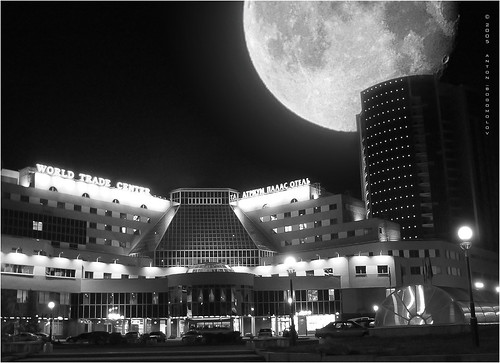I can't believe I have to explain to the Guardian that the moon is larger than a jogger.
The tedious and ridiculous “Supermoon” is back.
The Guardian call it “one of the natural world’s most spectacular light shows”. In fact, the moon is at the closest point to the Earth in its orbit, and it also happens to be a full moon. According to both the Guardian and the BBC,
The phenomenon, known as a perigee full moon, means the Moon appears up to 14% bigger and 30% brighter than when it is furthest from the planet.
Robert Massey, of the Royal Astronomical Society, told the BBC that although the phenomenon makes the moon appear 30% brighter, it is the apparent 14% increase in size ... that is most striking. "The eye is so good at compensating for changes in brightness that you simply don't notice so much,"
No, the reason we don’t notice the moon appearing 30% brighter is that it doesn’t.
The amount of light that hits the moon depends on the distance from the sun. Light leaves the sun equally in all directions, and if you imagine a load of photons leaving it at the same moment, you get a sphere, and as they fly through space they get more and more spread out. If you move the moon further away, more of them will miss it. The difference in light hitting the moon, between its closest and furthest points, is roughly 0.03%. That only accounts for a .05% change in brightness (and in fact, it’s dwarfed by variations in the Earth’s orbit around the Sun) so where does the other 29.95% come from?
Ah, but the distance to the Earth changes by more, right? Yes – by 14% if you go by the newspapers’ figures. Wolfram|Alpha puts it at nearer 12%. It’s not important. The important point is that once again the nearer the moon is to the Earth, the more light we get – but the more of the sky it takes up. And because both the amount of light and the area of moon in the sky increase at the same rate (the square of the distance) the actual brightness of the moon remains exactly constant. The brightness of the night, on the other hand, increases by a factor of (114%)² = 129.96%. I think it’s pretty clear what’s happened here.
It’s a coincidence that those numbers work out so neatly, obviously, but it does mean we can quantify the accuracy of the “30% brighter” claim: it is 0.17% truth and 99.83% misunderstanding of basic physics. Here’s that data as a graph: <div id="chart_div" style="width: 100%; height: 200px;"></div>
Ah, but look! They have photos! How can I pooh-pooh it when they have photos? Here’s the Guardian’s shot:
That’s a pretty big moon, but not because of the “supermoon”. That’s because of perspective. We all know the moon is larger than a jogger. It shouldn’t be impressive if it seems that way in a photo.
If you doubt me, here is that information presented as a graph: <div id="chart_div2" style="width: 100%; height: 200px;"></div> I mean, I think this is a pretty epic moon:
That was taken on 21 October 2005, when the moon was a little further away than normal. All you have to do to get this effect is to walk backwards and zoom in. Think about it: you can walk backwards for ages and the distance between you and the moon will basically stay the same. The distance between you and the jogger or the building in front of the moon will change a lot. So you can control the relative size of moon and jogger really easily, just like you can take a photo of your giant kid holding up a tiny Tower of Pisa if you really feel you must. And if you make the jogger small, then crop the image around the moon, the moon looks massive.
Because it is. Of course it is, it’s the sodding moon.
I suppose what annoys me about this story is that the ‘supermoon’ is too pathetic to be of interest to photographers, too banal to be of interest to astronomers, and arbitrarily not of interest to astrologers. So who cares? Nobody. Nobody cares. And yet it’s been in every newspaper going, two years on the trot. And it’s one thing when a newspaper does it, because it’s cheaper than doing journalism. But the BBC should be above it.

